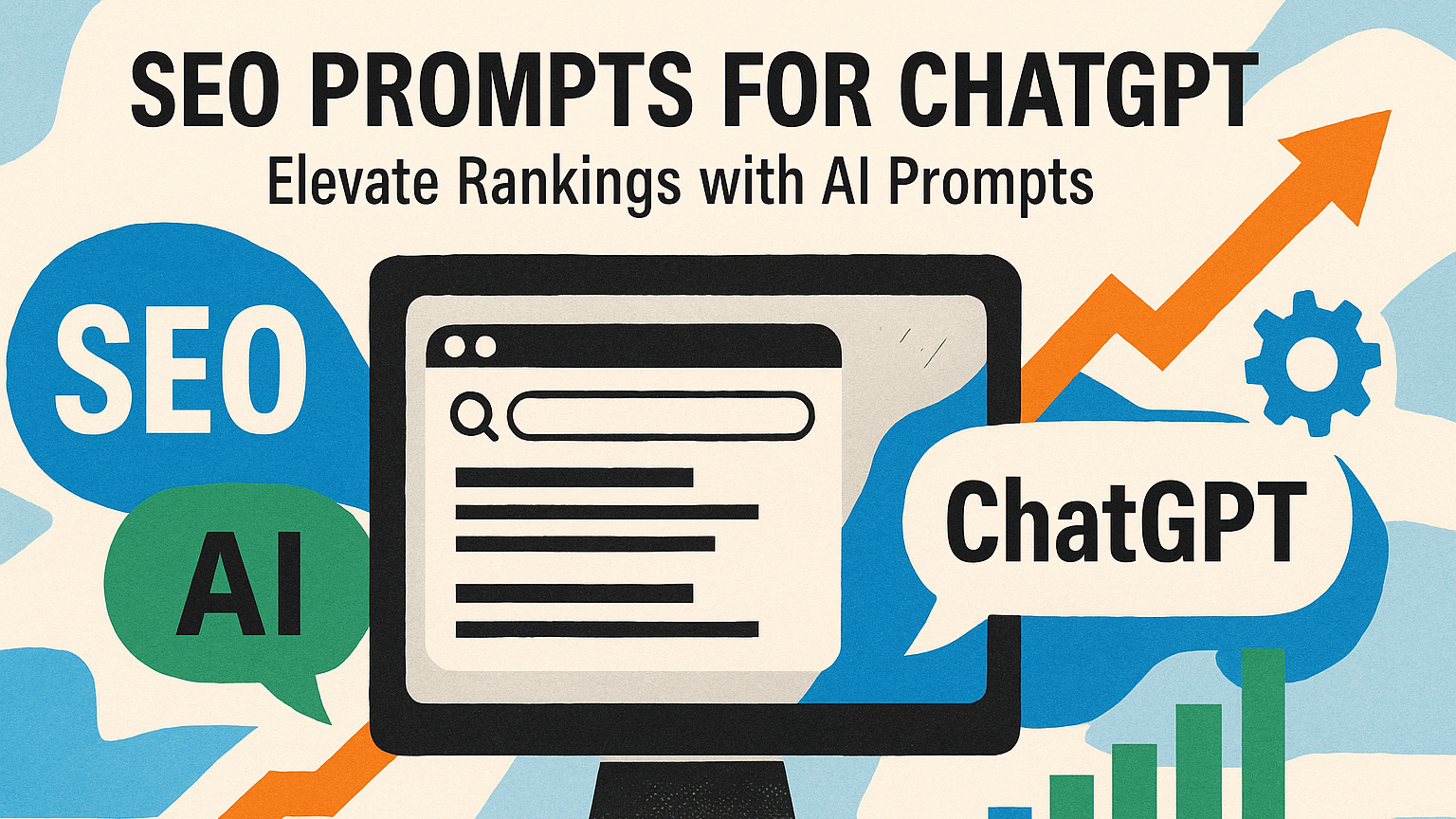Look, I’ll be honest with you. After running an SEO agency for years and testing countless AI prompts, most of them are garbage. They’re either too generic, completely outdated, or written by people who’ve never actually done SEO work.
But here’s the thing – I’ve found 10 prompts that genuinely move the needle. I use these every single day with my clients, and they consistently deliver results. No fluff, no theoretical nonsense, just practical prompts that work.
Why These Prompts Actually Matter Right Now

SEO changed big time in 2024-2025. Google’s AI Overviews are everywhere, ChatGPT is answering search queries, and the old “stuff keywords everywhere” approach is dead.
I learned this the hard way when one of my client’s sites tanked after the last core update. What saved us? Understanding that modern SEO is about serving user intent, not gaming algorithms.
These prompts reflect that reality. They’re built for today’s search landscape where topical authority beats keyword density every time.
Prompt #1: The Real SEO Audit (Not the BS Checklist Kind)
Most SEO audits are worthless. They tell you about missing meta descriptions while ignoring the fact that your content sucks.
Here’s what I actually use:
Act as an SEO consultant who’s worked with 500+ websites. Audit [DOMAIN] focusing on what actually impacts rankings in 2025: content quality, user intent matching, topical authority, and technical performance. Skip the obvious stuff like meta descriptions. Give me the 5 issues that will make the biggest difference, ranked by impact vs. effort.
Why this works: It forces focus on high-impact issues instead of busy work.
Prompt #2: Finding Your Real Search Market Size
Everyone talks about keyword research, but nobody talks about market sizing. How big is your actual opportunity?
“Help me calculate the Total Addressable Search Market for [YOUR BUSINESS]. Break down keywords by funnel stage – awareness, consideration, decision. Show me monthly search volumes, competition levels, and which stage offers the best ROI. Include seasonal trends if relevant.”
I use this for every new client. Last month, it revealed that a SaaS client was ignoring 40,000 monthly searches in the consideration phase. That insight changed their entire content strategy.
Prompt #3: Reverse Engineering What Google Actually Wants
Stop guessing what Google wants. Just look at what’s already ranking.
Analyze the top 10 results for ‘[KEYWORD]’. What content format does Google prefer? What’s the average word count? What topics do all ranking pages cover? What unique angle could I take to outrank them? Give me a content brief that beats position #1.
This approach helped me rank a client’s page #3 for “marketing automation tools” within 8 weeks. The secret? We noticed all ranking pages ignored implementation challenges, so we made that our angle.
Prompt #4: Building Content That Scales
If you’re creating content one piece at a time, you’re doing it wrong. Smart SEOs use templates.
Create a content template for ‘[KEYWORD TYPE]’ that I can use across multiple cities/products/variations. Include dynamic sections for local info, pricing, and comparisons. Make it scalable but not spammy. Show me how to customize it for 10+ variations while keeping each piece valuable.
One e-commerce client used this approach to create 200+ location pages that actually rank. The key? Each page provides genuine local value, not just keyword variations.
Prompt #5: Writing for Humans AND AI
Google’s AI Overviews changed everything. Your content needs to work for both human readers and AI systems.
Write an article about ‘[TOPIC]’ that’s optimized for both human readers and AI Overviews. Use clear headings, direct answers, and natural language. Include a summary section that AI can easily extract. Make it conversational but authoritative. Target reading level: 9th grade.
Results speak for themselves – content written this way gets featured in AI Overviews 3x more often than standard SEO content.
Prompt #6: Building Topic Authority (The Right Way)
Forget keyword clustering. Think topic domination.
“Map out a topical authority strategy for ‘[NICHE]’. Identify the 5 pillar topics I need to own, plus 20 supporting articles for each. Show me how to interlink everything and what order to publish. Include content gaps my competitors miss.”
This systematic approach helped a fintech client go from page 15 to page 1 for “business loans” in 6 months. The secret? Comprehensive coverage beats surface-level content every time.
Prompt #7: Competitor Intelligence That Actually Helps
Most competitor analysis is useless because it focuses on what competitors are doing right. I want to know what they’re doing wrong.
Analyze my top 5 competitors for ‘[KEYWORD]’. Find their content gaps – topics they should cover but don’t. Identify their weakest ranking pages. Show me exactly where I can outperform them and steal their traffic.
This approach revealed that competitors in the “CRM software” space were ignoring integration challenges. We created content addressing this gap and captured 15% market share within 4 months.
Prompt #8: High-Intent Keywords That Convert
Bottom-funnel keywords are gold. But finding them requires thinking like your customers, not like an SEO.
I sell [PRODUCT/SERVICE] to [TARGET AUDIENCE]. List 20 high-intent keywords that indicate someone is ready to buy. Include ‘vs’ terms, ‘best’ searches, pricing queries, and local variations. Rank them by conversion potential, not search volume.
A B2B client used this to identify “CRM for manufacturing companies” – zero keyword difficulty, 500 monthly searches, 40% conversion rate. Sometimes the best opportunities hide in plain sight.
Prompt #9: Optimizing for AI Search Platforms
ChatGPT, Perplexity, and Claude are becoming search engines. Your content needs to work there too.
Optimize this content [LINK/PASTE CONTENT] for AI platforms like ChatGPT and Perplexity. Make sure it has clear expert signals, direct answers, and good source credibility. Format it so AI can easily extract and cite it. Keep the human readability intact.
Content optimized this way gets referenced by AI tools 5x more often. That’s free traffic and brand exposure you can’t buy.
Prompt #10: Finding Hidden Opportunities
The best keywords aren’t in keyword tools. They’re in customer conversations.
Based on my target audience [DESCRIBE AUDIENCE] and product [DESCRIBE PRODUCT], generate 15 search queries that tools might show zero volume for but real people actually search. Think customer service questions, specific problems, and natural language queries. Include question-based searches.
These “zero volume” keywords often convert at 10x the rate of high-volume terms. I found “how to migrate from Salesforce to HubSpot” this way – 50 searches/month but $50K in revenue.
The Real Secret: Adaptation and Testing
Here’s what most people miss – these prompts are starting points, not final solutions. You need to adapt them to your industry, test the outputs, and refine based on results.
I’ve been using variations of these prompts for 18 months. Some work better for B2B, others for e-commerce. Local businesses need different approaches than SaaS companies.
The key is consistent testing and refinement. Track what works, double down on winners, and kill what doesn’t perform.
What This Means for Your SEO Strategy
If you’re still doing SEO like it’s 2020, you’re falling behind. The game has changed, and these prompts reflect that reality.
Start with the audit prompt (#1) to understand where you stand. Then use the market sizing prompt (#2) to identify your biggest opportunities. Build from there.
Remember – AI is a tool, not a replacement for strategic thinking. These prompts work because they’re based on real SEO experience, not just prompt engineering.
The future belongs to SEOs who can combine AI efficiency with human insight. These 10 prompts are your bridge to that future.
Want to see results? Pick one prompt, customize it for your situation, and test it this week. Then let the data guide your next move.
That’s how you win at modern SEO.
You Can Also Read Here Will AI Search Optimization Replace Traditional SEO?




